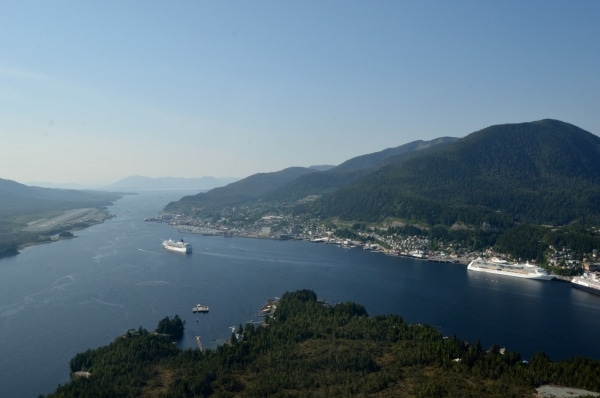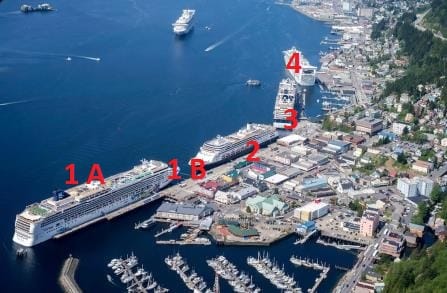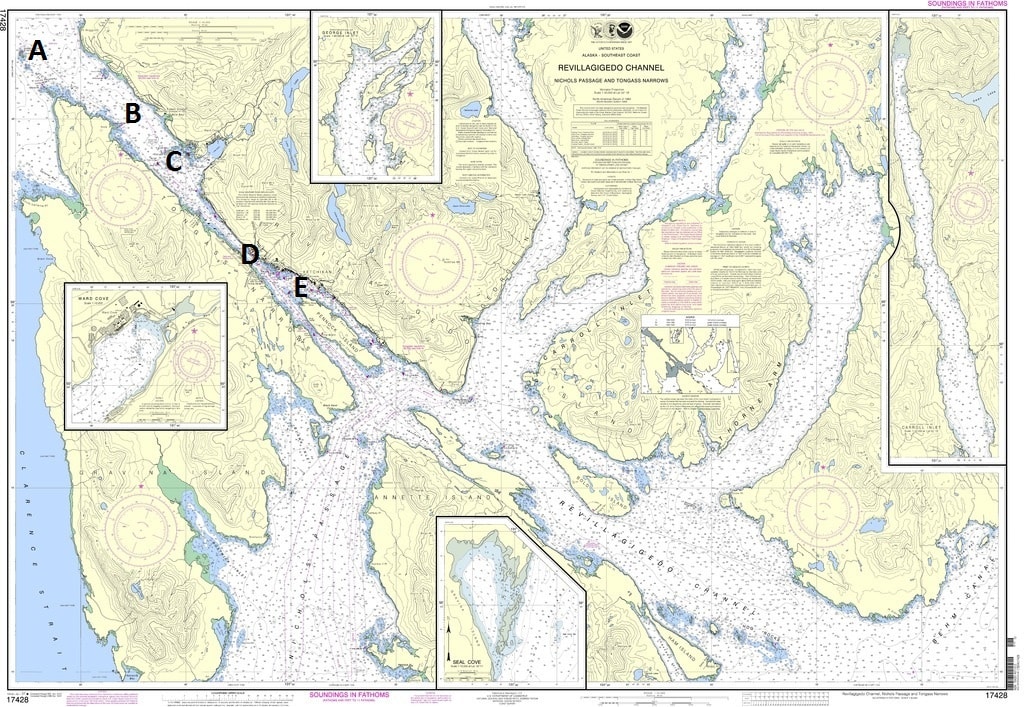As mentioned yesterday the ms Noordam was on a tight schedule to get to Ketchikan on time and thus we raced through the night from Juneau, via Cape Spencer and Snow Passage to Ketchikan. As there was no traffic to hold us up, the ship docked nicely on time at Berth 4 in Ketchikan. Berth 4 is the farthest to the north and also the farthest away from down town. (Although is there is shopping board walk to guide you there) We have been assigned to this dock because we were the last one coming in. On berth 1 we had the Oosterdam which arrived early and left at 13.00 hrs. Her spot was then immediately taken by the Celebrity Infinity. On berth 2, facing north was the Seven Seas Mariner, and on berth 3 was the Norwegian Pearl who had left Juneau earlier than us and thus could dock earlier as well. Four ships, four docks and the port was full again. That leaves one anchorage space in the middle of the harbor but it is normally only used on congested days. I think they have the first one on July 3 when then Grand Princess has to anchor during a full day call.

Tongass Narrows as seen from the south out of an airplane. (Courtesy: thank you to the unknown maker)
Ketchikan is partly sheltered by Tongass Narrows and to get there you have to sail through it completely during the journey either Northbound or Southbound. As there are houses and docks on either side of the Narrows there are speed restrictions. So we have a whole protocol to abide by. The pilot is the person ensuring that we do abide as it is his license on the line as being the Government Representative on board. Only if the captain would ignore the pilot’s advice in regards to the regulations, then the ship would be held responsible. The whole of the South East Alaska ports are covered by a rule book. The S.E Alaska Waterway Guide. All who are involved in navigating have to know its contents and if something changes, we will hear about it via the pilots, the ships agent and the Notices to Mariners; although the latter can be quite delayed in coming to us as it has to go through governmental pipe lines.
The north point of Tongass Narrows is defined by Guard Island (A), a clever name as indeed the lighthouse on top of it guards the entrance. At this point the ship will slow down its speed to full maneuverable. This means the engines come down from a most economical sea setting to where we can pull the handles without causing any issues with the propulsion. (The ships engines are always ready to slow down but a gentle way is preferred when high temperatures are involved) Then it is about two miles until we come to Rosa Reef (B) which is a small reef sticking out from the southern shore. There we have to be down to 16 knots. The next location is Ship Island (C) where we have to be down to 10 knots. This speed is universally considered a no-wake-speed and that will protect the boats and floats along the sides of the Narrows which are now becoming more and narrower here.
Next step is when we pass Tongass Dry-dock (D) opposite the airport. Due to the floating dry dock, the Narrows are now really narrow and thus we have to be down to 7 knots. Here is also a small ferry crossing for people to go from Ketchikan to the Airport and vice versa. The seven knots speed limit is in force for the whole port area and thus we can adjust the speed for the rest of the distance to the dock to our own liking. Normally we approach the dock (E) with a speed of about 3 knots and then let the Azipods trail astern to come to a standstill in the right position. That right position is where the gangways will be located and as dock 4 has a floating pontoon to accommodate a tide-less gangway, that is where we have to aim for.

Downtown Ketchikan, with cruise ships in port on a congested port day as also the anchorage is occupied.
Ketchikan did let us know a few times during the day that it is the Rainy Capital of the World but there was no wind, so it was not that chilly when being ashore.
We will sail after 18.30 hrs. to get back to Canada ad after an hour forward to get back into the Canadian Time zone we will sail the Inside Passage from around noon time onwards. It is expected to remain a bit rainy.


July 15, 2017 at 12:36 am
re: The ships engines are always ready to slow down but a gentle way is preferred when high temperatures are involved.
As it also was in my days @ sea on ships with steam boilers and engines.
Greg Hayden